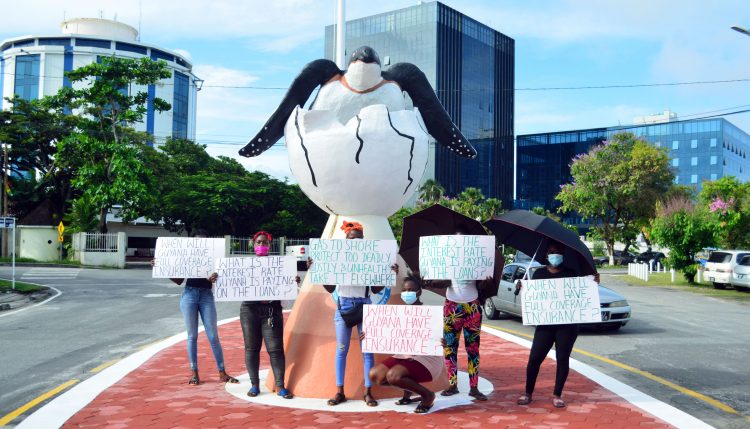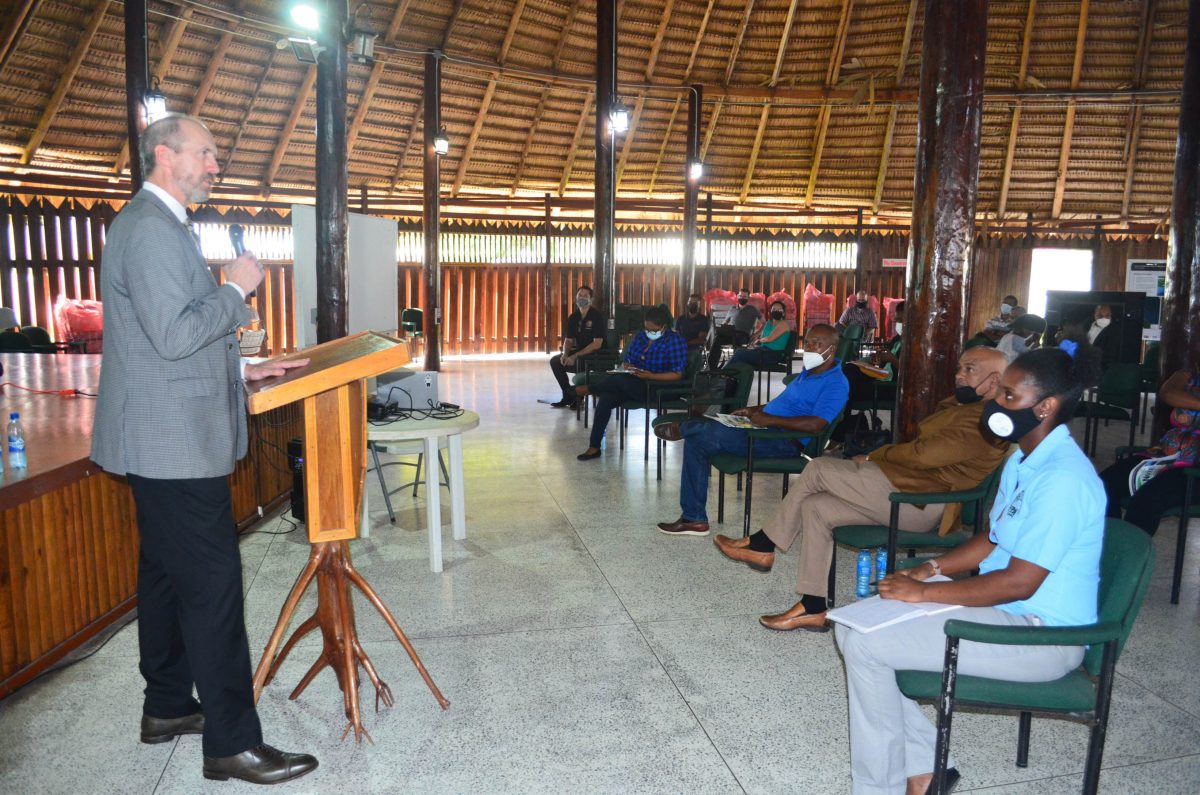ExxonMobil and the EPA were yesterday buffeted with questions at a public meeting as to why a gas-to-shore energy project was being undertaken when renewable fuels could provide the same output without damaging the environment and worsening climate change.
The arguments were made at a meeting at the Umana Yana which is part of a series intended to craft the terms of reference for the Environmental Impact Assessment (EIA) for the massive US$900 million project to pipe associated gas from Guyana’s offshore oil wells to be transformed into energy at a plant at Wales, West Bank Demerara.
Yesterday’s session came after a virtual meeting on Thursday where ExxonMobil’s affiliate, Esso Exploration and Production Guyana Limited (EEPGL) and the Environmental Protection Agency (EPA) faced a barrage of questions from Guyanese professionals on who would be owner of the gas piped ashore and why there were plans to sell portions of it to an unknown third party.

EEPGL submitted an application to the EPA in June this year for an environmental authorisation. The Company notes in the summary that it entails the construction and operation of a 12-inch pipeline, approximately 220 kilometers long from the Liza Phase 1 and Liza Phase 2 Float-ing, Production, Storage and Offloading (FPSO) vessels in the offshore Stabroek Block, to an onshore natural gas liquids (NGL) and natural gas processing plant (NGL Plant) located at Wales. The pipeline is expected to transport up to approximately 50 million standard cubic feet per day (MMSCFD) of dry gas to the Natural Gas Liquid Plant but has a maximum flow of approximately 120 MMSCFD.
During the meeting yesterday, several persons questioned the need for such a project, especially since there are others in the works that would cater for a similar amount of energy and would be less costly. It was pointed out there are projects such as the 165-MW Amaila Falls Hydro-power Project along with the Hope Wind Farm project, which boast almost the same services as the gas-to-energy project and which are more environmentally-friendly. It was also stated that the government has been leaning towards providing solar energy, where those projects may fall short, which is notably, also, less costly.
According to several attendees, the fact that so many energy-related projects are expected to be undertaken but there is still need for a gas-to-shore energy project does not make any sense.
Commenting on this issue, one of the attendees stated that it seems as though no one has done a proper study even as energy seems to be their primary concern. “This project doesn’t make an ounce of sense. There are power plants in Kingston, Garden of Eden, Berbice and here we are talking about fire in the sea wherever the pipeline goes“, he said, while noting that if this project goes ahead the proper systems have to be in place to address such issues.
However, he noted that the existing power plants are using heavy fuels and this gas project will allow Guyana to use fuel that is less damaging to the environment so the real question would be, “How soon will we be able to replace gas with total renewables?”
Proprietor of the Kaieteur News, Glenn Lall subsequently questioned EEPGL representative and Production Manager Mike Ryan as to why the Company is imposing such a costly and potentially disastrous project on the Guyanese people if other renewable options are available.
He went on to state that such a project need not exist even as a transitional
venture as one can move straight from fossil fuels to renewable energy, albeit slowly. He noted that the hydropower project would not cost Guyana as much money as the gas-to-shore project.
Several persons went on to ask for confirmation that there are indeed several energy-related projects ongoing in Guyana and the EPA in response stated that there are some in operation while others are in the works. “Oh, so then we don’t need fossil fuels anymore, the world is moving away from that?” an attendee subsequently asked.
Guidelines
Apart from that, the question as to whether the recently withdrawn new Environmental Impact Assessment (EIA) guidelines would be included in the terms of scope for the EIA was once again brought to the forefront. However, the EPA said that the guidelines were withdrawn so that further consultations can be done and noted that even those guidelines specifically catered for offshore oil and gas operations but that the gas-to-shore component of it was not factored into those guidelines.
Despite that response, many were of the opinion that those guidelines were still critical as they would have contained key regulations on the oil and gas industry.
It was also asked whether ExxonMobil and its partners would be providing insurance coverage should there be a blowout or if a pipeline is damaged as they are yet to disclose whether they have signed the document mandating parent companies to provide full insurance coverage should there be an oil spill.
Several persons made their dissatisfaction regarding insurance coverage known as they protested outside the Umana Yana.
The EPA said that if authorization is given, liability and legal fees and other aspects relevant to the permit will be included while Ryan stated that they will operate in line with international best practices and come under the guidelines of the Ministry of Natural Resources and the EPA.
Meanwhile, Ryan disclosed that the projected US$900 million cost of the project is only an estimate and this figure can rise.
With the impact assessment for the Wales gas-to-shore project imminent, the EPA has invited public submissions on the scope of the study for the project which is expected to begin operations in 2024. In a public notice, the EPA noted that the project, with attendant onshore and offshore components, could have possible effects on the environment, including impacts to marine water quality, air quality, marine and terrestrial flora and fauna and socio-economic resources, among others
As a result, it has determined that an EIA must be undertaken before the project is approved. Members of the public are invited to make written submissions to the agency, within 28 days of the EPA notice, setting out those questions and matters which they require to be answered or considered in the EIA.
The planned government-owned power plant is not included in the scope of the project’s application, except for its consideration when addressing cumulative impacts for the Project.
Persons have until July 25 to send questions or submissions to the EPA so that their concerns may be considered in the EIA.
EEPGL will pay for the environmental and social impact assessment (ESIA) and other studies. It will also be selecting the consultant for the project since, according to this country’s current EPA Act, the contractor has to select the consultant from an EPA-approved list of persons.
The next scheduled public scoping meeting will be held on Monday at the Diamond Primary School at 5:30 pm.
On Thursday at the virtual hearing, Simone Mangal asked “Who owns the gas? Is it a joint venture? Who owns the pipeline? Who is the selling the gas? How much dry gas does the country demand?” She also demanded to know the purpose of transporting gas through a pipeline to Guyana only for it be sold to third parties.
Maya Trotz asked if local demand is enough for such a project to be undertaken and if climate change was taken into consideration before a decision was made to undertake the project. “It would be helpful to have access to all the documents [relating] to the project,” she contended.
Director of the World Wildlife Fund (WWF) Guianas Dr David Singh stated that he recognises that this is the largest project in Guyana’s history and stated that the WWF will be making detailed submissions to the EPA.





